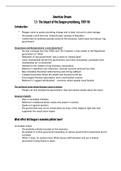Summary
Summary Unit 1F: In Search of the American Dream- Topic 5: The Impact of the Reagan Presidency, 1981-96
- Course
- Institution
Full notes(pdf) from textbook for Unit 1F: In Search of the American Dream- Topic 5 : The Impact of the Reagan Presidency, 1981-96 Revision Notes Edexcel AS/A Level
[Show more]



